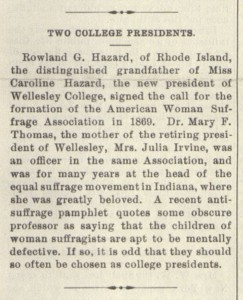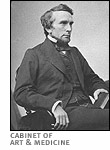 As part of our celebration of Women’s History Month, The Albert M. Greenfield Digital Center for the History of Women’s Education is featuring content from The Woman’s Column, a pro-suffrage publication from the late nineteenth and early twentieth centuries. Bryn Mawr College Special Collections recently acquired a large holding of print copies of the Column, and we will be blogging about articles and findings from the newsletter every week during March. This post is the second installment in that series; check out our first post on this amazing newsletter here.
As part of our celebration of Women’s History Month, The Albert M. Greenfield Digital Center for the History of Women’s Education is featuring content from The Woman’s Column, a pro-suffrage publication from the late nineteenth and early twentieth centuries. Bryn Mawr College Special Collections recently acquired a large holding of print copies of the Column, and we will be blogging about articles and findings from the newsletter every week during March. This post is the second installment in that series; check out our first post on this amazing newsletter here.
Alongside the general news updates on suffrage activity and women’s rights, The Woman’s Column regularly published short opinion pieces and commentary responding to specific remarks made by public figures or commonly held opinions of the day. This post highlights an article which illustrates some of the interesting cultural shifts that were taking place at the end of the nineteenth century.
The short piece on the left, entitled “Two College Presidents,” points to the well-documented support of equal suffrage espoused by the parents of two prestigious women’s college presidents. The author uses the two examples as a counter-argument to the recent claim, attributed to “some obscure professor,” that “the children of woman suffragists are apt to be mentally defective.”
“If so,” the author comments sardonically, “it is odd that they should so often be chosen as college presidents.” This pithy article, published on March 11th, 1899, is a mark of the incredible pace of changing ideas at the dawn of the twentieth century about what was best for women and what they were capable of.
At the time, higher education was still being established as a respectable and appropriate pursuit for young women. As recently as the 1870s, authors like Edward H. Clarke and others had captured public attention with their assertion that the rigors of higher education could have disastrous consequences for women’s physical health due to their weaker constitution. Amidst the debate over women’s capacity for intellectual activity, the colleges known as the Seven Sisters were successfully established between the years 1865 and 1889 and defined a site upon which the advocates and opponents of female education would see their theories proven true or false. As one Wellesley alumna from the class of 1879 recalled, “We were pioneers in the adventure—voyagers in the crusade for the higher education of women—that perilous experiment of the 1870s which all the world was breathlessly watching and which the prophets were declaring to be so inevitably fatal to the American girls.”1
The idea that women might be somehow genetically unfit for learning therefore colored the early years of schools like Wellesley: while female higher learning was at stake, the reputations of the institutions that offered it were very unstable until women demonstrated their success in the academic sphere and beyond throughout the following decades. (The emergence in this period of institutions of women’s higher education, and the societal perception that developed around them, is more fully explored in our exhibition Taking Her Place, currently on view in Canaday Library at Bryn Mawr College. Click here to learn more.)
The reference to Wellesley in the article mentioned above therefore suggests that by 1899 a surprisingly advanced shift had taken place in the status of women’s colleges in the public view. It is, of course, expected that a publication dedicated to equal suffrage rights would be in support of equal education as well (as we explored in our previous post), and opinions published in The Woman’s Column should not be taken as a broadly representative of public perspectives2. However, the article boldly implies that the opinion of this “obscure professor” is universally discredited based on the evidence that the children of suffragists are not, in fact “mentally defective.” Only two decades after the public vocally doubted that women could physically survive a college education, affiliation with an institution of women’s higher learning was being used to validate the reputation of the individual, and to lend credit to the suffrage movement as a whole by association. Women’s higher education had become stable and respectable enough, in the eyes of many, to shoulder the weight of bolstering another movement that was receiving scrutiny.
In some ways, however, the landscape had not changed very much at all since Edward Clarke’s gloomy prophesies of thirty years before: the points of the debate still centered around parental lineage and the effects of radical ideas upon future generations. The arguments against women’s education in the mid-nineteenth century were often motivated by anxiety over women’s reproductive habits and abilities: the crux of the anti-education stance was that education would inhibit reproduction, either by causing stress that could physically wither women’s reproductive organs (see Clarke, Smith), or by diminishing their interest in marriage and child-rearing. The arguments boiled down to a single point: whatever dangerous consequences education held for women could trigger a magnified ripple-effect upon the race as a whole.
Education proponents also leveraged this idea: a more popular and persuasive alternative to arguing that women should be able to access education for their own sake was the notion that education could improve a woman’s ability to perform her familial and maternal duties. As a companion to her husband, a keeper of a household, and a mother and teacher to her children, women’s ability to enhance the lives of those around her could be furthered by some measure of education. This line of thinking is well documented in publications such as The Ladies’ Companion and The Ladies’ Garland, monthly magazines that were considered proper reading for respectable middle-class women.
Mary Wollstonecraft famously argued this position in 1792 in A Vindication of the Rights of Woman: With Strictures on Political and Moral Subjects, a work that is widely considered to be the first feminist treatise (a first edition of Vindication, and several ladies’ periodicals like the ones referenced above, are featured texts in our exhibition Taking Her Place). As a compromise between the radical ideal of education for the sake of intellectual development and the conservative conviction that women were not fit to be educated at all, it was palatable to both sides to argue that women’s education should hinge on their role as mothers and wives. It was through these roles that they wielded their influence: under-educated mothers might not be prepared to instill essential knowledge and moral values into their children, and it was ultimately for the benefit of those children (especially the sons) that women should be educated.
Though shorter and less substantial than many of the other pieces of writing published in The Woman’s Column and its sister publication, The Woman’s Journal, brief articles such as this one help to illustrate the intricacies of a monumental shift in the public view of women’s proper role and her scope of power. Next week this train of thought will be continued with another short article from The Column that references and provides an interesting twist on some of the same cultural beliefs discussed in this post. Watch this space for the next installment!
1. LMN, “Speech for ’79 and the Trustees at Semi-Centennial,” 2, Unprocessed LMN Papers, WCA; also LMN, “A Wellesley Retrospect,” WAM 14, No. 2 (Dec. 1929): 54-56.
2. Public opinion was still very much split over the issue, and the gap between conservative and radical positions was widening dramatically. Indeed, just eight months after this article ran, Harvard President Charles Eliot delivered a speech at the inauguration of Wellesley College President Caroline Hazard that was full of remarks that would not have been out of place two decades earlier. Among the (even then) antiquated notions that he espoused were the ideas that women should be discouraged from academic rigor for medical reasons, and that intellectually vital women’s colleges were irrelevant because there was no viable place for women outside the home. M. Carey Thomas, President of the fourteen-year-old Bryn Mawr College, was present at the inauguration. She expressed her disdain for his views in a personal letter: “Eliot disgraced himself. He said the traditions of past learning and scholarship were of no use to women’s education, that women’s words were as unlike men’s as their bodies, that women’s colleges ought to be schools of manners and really was hateful.” (M. Carey Thomas to Mary E. Garrett, Oct. 3, 1899, Papers of M. Carey Thomas, reel 22, frame 540)



Pingback: “Educate the Mothers”: The Woman’s Column and the Changing Perception of Women’s Influence | Educating Women